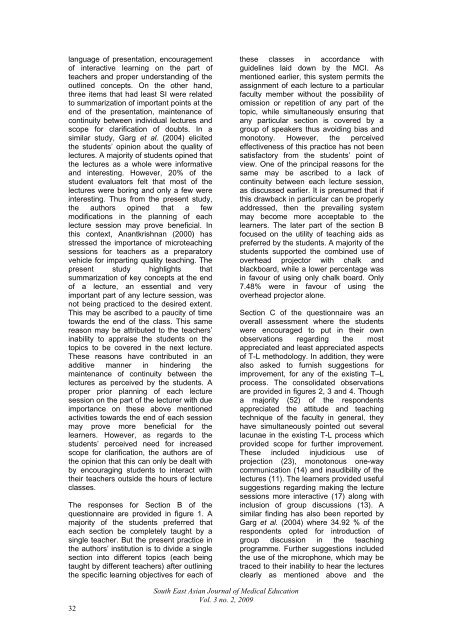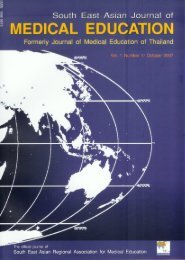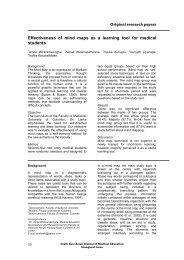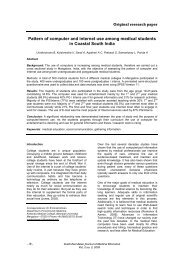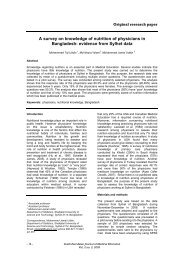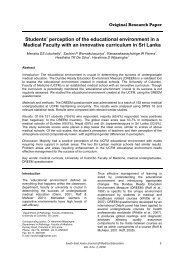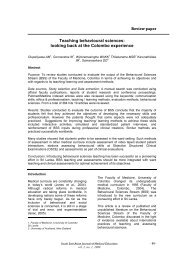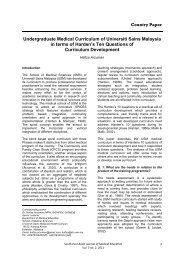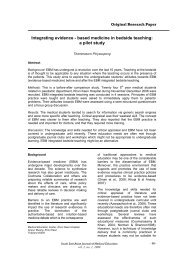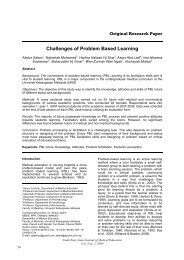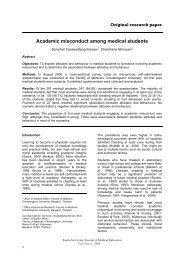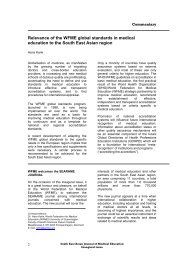Assessment of perception of first professional MBBS students in ...
Assessment of perception of first professional MBBS students in ...
Assessment of perception of first professional MBBS students in ...
Create successful ePaper yourself
Turn your PDF publications into a flip-book with our unique Google optimized e-Paper software.
language <strong>of</strong> presentation, encouragement<br />
<strong>of</strong> <strong>in</strong>teractive learn<strong>in</strong>g on the part <strong>of</strong><br />
teachers and proper understand<strong>in</strong>g <strong>of</strong> the<br />
outl<strong>in</strong>ed concepts. On the other hand,<br />
three items that had least SI were related<br />
to summarization <strong>of</strong> important po<strong>in</strong>ts at the<br />
end <strong>of</strong> the presentation, ma<strong>in</strong>tenance <strong>of</strong><br />
cont<strong>in</strong>uity between <strong>in</strong>dividual lectures and<br />
scope for clarification <strong>of</strong> doubts. In a<br />
similar study, Garg et al. (2004) elicited<br />
the <strong>students</strong>’ op<strong>in</strong>ion about the quality <strong>of</strong><br />
lectures. A majority <strong>of</strong> <strong>students</strong> op<strong>in</strong>ed that<br />
the lectures as a whole were <strong>in</strong>formative<br />
and <strong>in</strong>terest<strong>in</strong>g. However, 20% <strong>of</strong> the<br />
student evaluators felt that most <strong>of</strong> the<br />
lectures were bor<strong>in</strong>g and only a few were<br />
<strong>in</strong>terest<strong>in</strong>g. Thus from the present study,<br />
the authors op<strong>in</strong>ed that a few<br />
modifications <strong>in</strong> the plann<strong>in</strong>g <strong>of</strong> each<br />
lecture session may prove beneficial. In<br />
this context, Anantkrishnan (2000) has<br />
stressed the importance <strong>of</strong> microteach<strong>in</strong>g<br />
sessions for teachers as a preparatory<br />
vehicle for impart<strong>in</strong>g quality teach<strong>in</strong>g. The<br />
present study highlights that<br />
summarization <strong>of</strong> key concepts at the end<br />
<strong>of</strong> a lecture, an essential and very<br />
important part <strong>of</strong> any lecture session, was<br />
not be<strong>in</strong>g practiced to the desired extent.<br />
This may be ascribed to a paucity <strong>of</strong> time<br />
towards the end <strong>of</strong> the class. This same<br />
reason may be attributed to the teachers’<br />
<strong>in</strong>ability to appraise the <strong>students</strong> on the<br />
topics to be covered <strong>in</strong> the next lecture.<br />
These reasons have contributed <strong>in</strong> an<br />
additive manner <strong>in</strong> h<strong>in</strong>der<strong>in</strong>g the<br />
ma<strong>in</strong>tenance <strong>of</strong> cont<strong>in</strong>uity between the<br />
lectures as perceived by the <strong>students</strong>. A<br />
proper prior plann<strong>in</strong>g <strong>of</strong> each lecture<br />
session on the part <strong>of</strong> the lecturer with due<br />
importance on these above mentioned<br />
activities towards the end <strong>of</strong> each session<br />
may prove more beneficial for the<br />
learners. However, as regards to the<br />
<strong>students</strong>’ perceived need for <strong>in</strong>creased<br />
scope for clarification, the authors are <strong>of</strong><br />
the op<strong>in</strong>ion that this can only be dealt with<br />
by encourag<strong>in</strong>g <strong>students</strong> to <strong>in</strong>teract with<br />
their teachers outside the hours <strong>of</strong> lecture<br />
classes.<br />
The responses for Section B <strong>of</strong> the<br />
questionnaire are provided <strong>in</strong> figure 1. A<br />
majority <strong>of</strong> the <strong>students</strong> preferred that<br />
each section be completely taught by a<br />
s<strong>in</strong>gle teacher. But the present practice <strong>in</strong><br />
the authors’ <strong>in</strong>stitution is to divide a s<strong>in</strong>gle<br />
section <strong>in</strong>to different topics (each be<strong>in</strong>g<br />
taught by different teachers) after outl<strong>in</strong><strong>in</strong>g<br />
the specific learn<strong>in</strong>g objectives for each <strong>of</strong><br />
these classes <strong>in</strong> accordance with<br />
guidel<strong>in</strong>es laid down by the MCI. As<br />
mentioned earlier, this system permits the<br />
assignment <strong>of</strong> each lecture to a particular<br />
faculty member without the possibility <strong>of</strong><br />
omission or repetition <strong>of</strong> any part <strong>of</strong> the<br />
topic, while simultaneously ensur<strong>in</strong>g that<br />
any particular section is covered by a<br />
group <strong>of</strong> speakers thus avoid<strong>in</strong>g bias and<br />
monotony. However, the perceived<br />
effectiveness <strong>of</strong> this practice has not been<br />
satisfactory from the <strong>students</strong>’ po<strong>in</strong>t <strong>of</strong><br />
view. One <strong>of</strong> the pr<strong>in</strong>cipal reasons for the<br />
same may be ascribed to a lack <strong>of</strong><br />
cont<strong>in</strong>uity between each lecture session,<br />
as discussed earlier. It is presumed that if<br />
this drawback <strong>in</strong> particular can be properly<br />
addressed, then the prevail<strong>in</strong>g system<br />
may become more acceptable to the<br />
learners. The later part <strong>of</strong> the section B<br />
focused on the utility <strong>of</strong> teach<strong>in</strong>g aids as<br />
preferred by the <strong>students</strong>. A majority <strong>of</strong> the<br />
<strong>students</strong> supported the comb<strong>in</strong>ed use <strong>of</strong><br />
overhead projector with chalk and<br />
blackboard, while a lower percentage was<br />
<strong>in</strong> favour <strong>of</strong> us<strong>in</strong>g only chalk board. Only<br />
7.48% were <strong>in</strong> favour <strong>of</strong> us<strong>in</strong>g the<br />
overhead projector alone.<br />
Section C <strong>of</strong> the questionnaire was an<br />
overall assessment where the <strong>students</strong><br />
were encouraged to put <strong>in</strong> their own<br />
observations regard<strong>in</strong>g the most<br />
appreciated and least appreciated aspects<br />
<strong>of</strong> T-L methodology. In addition, they were<br />
also asked to furnish suggestions for<br />
improvement, for any <strong>of</strong> the exist<strong>in</strong>g T–L<br />
process. The consolidated observations<br />
are provided <strong>in</strong> figures 2, 3 and 4. Though<br />
a majority (52) <strong>of</strong> the respondents<br />
appreciated the attitude and teach<strong>in</strong>g<br />
technique <strong>of</strong> the faculty <strong>in</strong> general, they<br />
have simultaneously po<strong>in</strong>ted out several<br />
lacunae <strong>in</strong> the exist<strong>in</strong>g T-L process which<br />
provided scope for further improvement.<br />
These <strong>in</strong>cluded <strong>in</strong>judicious use <strong>of</strong><br />
projection (23), monotonous one-way<br />
communication (14) and <strong>in</strong>audibility <strong>of</strong> the<br />
lectures (11). The learners provided useful<br />
suggestions regard<strong>in</strong>g mak<strong>in</strong>g the lecture<br />
sessions more <strong>in</strong>teractive (17) along with<br />
<strong>in</strong>clusion <strong>of</strong> group discussions (13). A<br />
similar f<strong>in</strong>d<strong>in</strong>g has also been reported by<br />
Garg et al. (2004) where 34.92 % <strong>of</strong> the<br />
respondents opted for <strong>in</strong>troduction <strong>of</strong><br />
group discussion <strong>in</strong> the teach<strong>in</strong>g<br />
programme. Further suggestions <strong>in</strong>cluded<br />
the use <strong>of</strong> the microphone, which may be<br />
traced to their <strong>in</strong>ability to hear the lectures<br />
clearly as mentioned above and the<br />
32<br />
South East Asian Journal <strong>of</strong> Medical Education<br />
Vol. 3 no. 2, 2009


